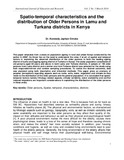| dc.description.abstract | This paper emanates from a study on population ageing in rural and urban Kenya conducted by the
author in 20081. Its thrust lies on the need to understand the roles, if at all, of spatial and temporal
factors in explaining the observed distribution of the older persons in both the leading ageing
district of Lamu and lagging ageing district of Turkana in Kenya. The study population constituted all
old persons aged 60 years and above in both Lamu and Turkana districts. A sample of 100 older
persons from Lamu district and a similar one from Turkana district was selected for the study using
both respondent-driven and random sampling procedures. To realize the desired outcomes, data
was analyzed using both descriptive and inferential methods. This paper gives an analysis of
peoples’ perceptions regarding aspects such as rocks, soils, water, vegetation and climate as they
relate to the distribution of the older persons and the general population. It is concluded that spatiotemporal
factors namely lithology related aspects, climate variability, water availability and conflict
induced migrations are important considerations in explaining the distribution of the older persons
in these areas. | en_US |

